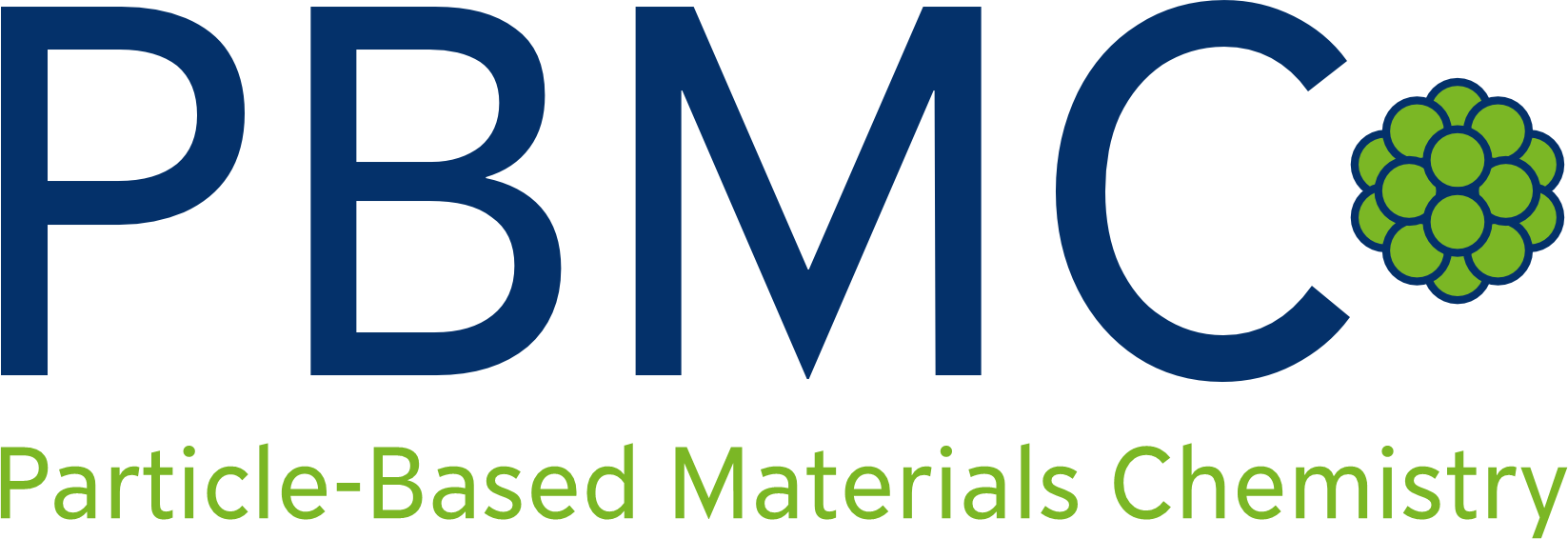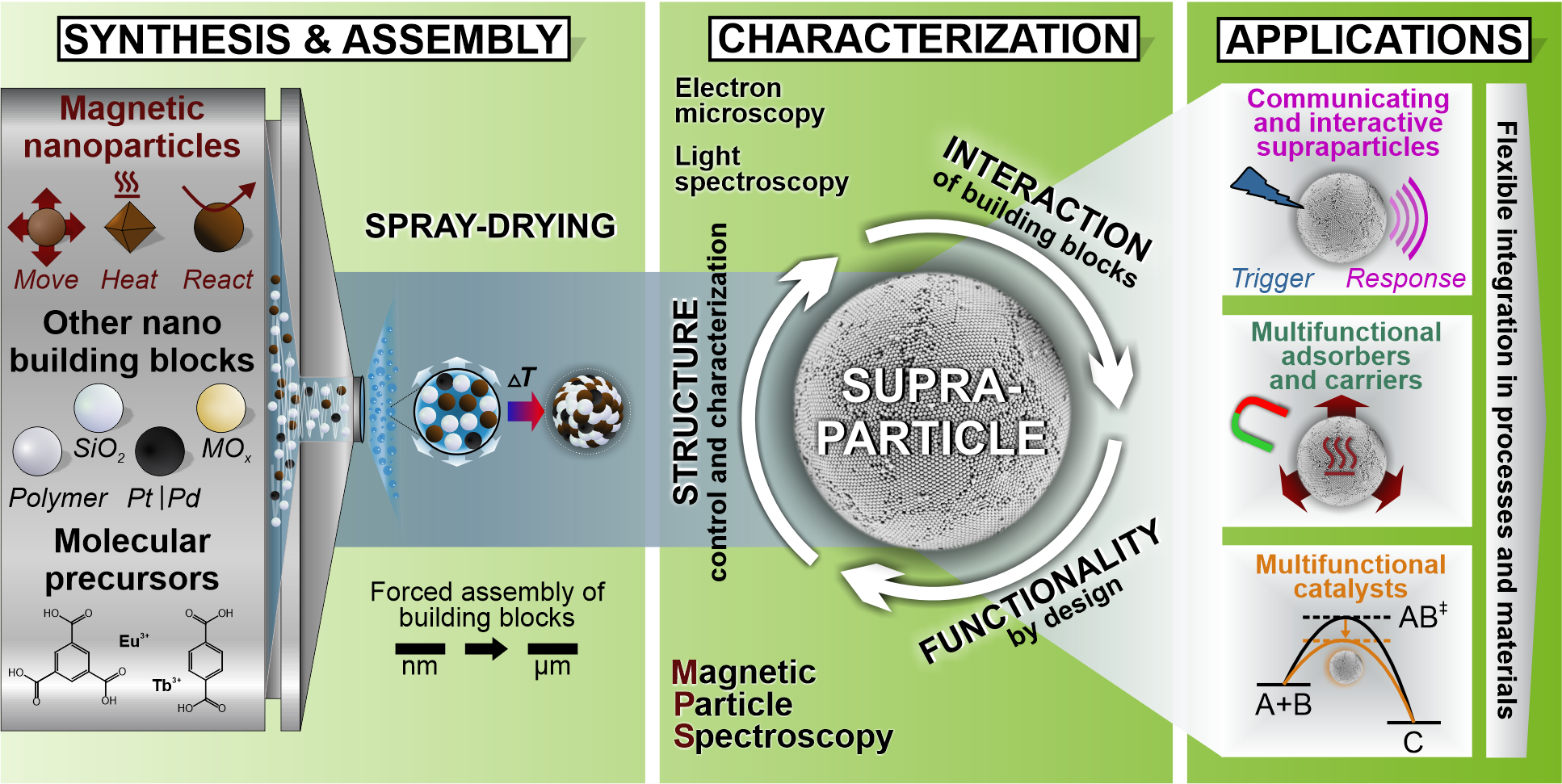Research
Research
In the Mandel group, we design highly functional supraparticles, i.e., particles of a few µm in size that are composed of nanoparticle (and molecular) building blocks.
These complex entities are achieved via forced assembly of the (nano) building blocks, mainly by using the technique of spray-drying.
We study how structure, besides (multimaterial) composition, of such supraparticles affects the interaction among the building blocks of these entities and how this leads to unique functionalities.
We exploit these findings for designing highly innovative communicating / interactive supraparticles and multifunctional adsorber / carrier and catalyst entities.
Many different material systems are studied in the group, but a special focus is on iron oxide nanoparticle-based magnetic systems and their characterization in particularly via magnetic particle spectroscopy (MPS), a to date rather unexplored approach that we pioneer.
Our research fields in focus:
![]()
Size, shape and composition determine the ultimate properties of nanoparticles. Chemical synthesis control enables tailoring these. We synthesize and surface functionalize nanoparticles by means of bottom-up wet chemistry and subsequently use these as building blocks to assemble functional supraparticles. A main interest is on magnetic, luminescent, adsorber and catalyst nano building blocks.
Selected publications:
, Schötz S., Stockinger N., Wintzheimer S., Mandel K., Libuda J., Retzer T.
Supraparticles for naked-eye H2 indication and monitoring: improving performance by variation of the catalyst nanoparticles
In: The Journal of Chemical Physics (2023)
DOI: 10.1063/5.0135130
, Mandel K., Löbmann P.
The Significant Influence of the pH Value on Citrate Coordination upon Modification of Superparamagnetic Iron Oxide Nanoparticles
In: Particle and Particle Systems Characterization (2022)
DOI: 10.1002/ppsc.202100279
, ,
Overcoming the Inhibition Effects of Citrate: Precipitation of Ferromagnetic Magnetite Nanoparticles with Tunable Morphology, Magnetic Properties and Surface Charge
via Ferrous Citrate Oxidation
In: Particle and Particle Systems Characterization (2021)
DOI: 10.1002/ppsc.202100098
, ,
Oxidative Precipitation as a Versatile Method to Obtain Ferromagnetic Fe3O4 Nano- and Mesocrystals Adjustable in Morphology and Magnetic Properties
In: Particle & Particle Systems Characterization (2021)
DOI: 10.1002/ppsc.202000307
![]()
Upon droplet evaporation, using the tool spray-drying, forced assembly of nano building blocks to supraparticles is possible. Furthermore, via this method, also molecular precursors and molecules can be joined, i.e., we can also perform “chemistry in a droplet”.
We study how structure, besides composition, of such supraparticles affects the interaction among the building blocks of these entities and how this leads to unique functionalities.
Selected publications:
, Luthardt L., Cao K.L.A., Imaz I., Maspoch D., Ogi T., Bück A., Debecker D.P., Faustini M., Mandel K.
Multifunctional, hybrid materials design via spray-drying: much more than just drying
In: Advanced Materials (2023)
DOI: 10.1002/adma.202306648
, Bleyer G., Endres J., Prieschl J., Vogel N., Wintzheimer S., Mandel K.
Spray-dried photonic balls with a disordered/ordered hybrid structure for shear stress indication
In: Small (2022)
DOI: 10.1002/smll.202203068
, Eigen A., Wintzheimer S., Prieschl J., Hirsch A., Halik M., Mandel K.
Supraparticles with a mechanically triggerable color-change-effect to equip coatings with the ability to report damage
In: Small (2022)
DOI: 10.1002/smll.202107513
, Granath T., Seufert M. T., Kasper T., Müller-Buschbaum K., Mandel K.
Luminescent magnets: hybrid supraparticles of a lanthanide-based MOF and ferromagnetic iron oxide by assembly in a droplet via spray-drying
In: Journal of Materials Chemistry C (2022)
DOI: 10.1039/D1TC04867H
Müssig S., Koch V. M., Cuadrado C. C., Bachmann J., Thommes M., Barr M. K. S., Mandel K.
Spray-Drying and Atomic Layer Deposition: Complementary Tools toward Fully Orthogonal Control of Bulk Composition and Surface Identity of Multifunctional Supraparticles
In: Small Methods (2021)
DOI: 10.1002/smtd.202101296
![]() We believe that supraparticles can be turned into communicating and interactive objects – a vision that we would like to become reality. Particles are developed that carry unique IDs, are able to perceive and subsequently report environmental stimuli, and can transform their state – which includes principles of micro reactor / micro ecosystems in a particle.
We believe that supraparticles can be turned into communicating and interactive objects – a vision that we would like to become reality. Particles are developed that carry unique IDs, are able to perceive and subsequently report environmental stimuli, and can transform their state – which includes principles of micro reactor / micro ecosystems in a particle.
Selected publications:
Magnetic Supraparticles as Identifiers in Single-Layer Lithium-Ion Battery Pouch Cells
In: ChemSusChem (2024)
DOI: 10.1002/cssc.202401142
, Müssig S.,, Mandel K.
Communicating supraparticles to enable perceptual, information-providing matter
In: Advanced Materials (2023)
DOI: 10.1002/adma.202306728
, Müssig S., Prieschl J., Genin E., Heuzé K., Fidler F., Haddad D., Wintzheimer S., Mandel K.
Optically sensitive and magnetically identifiable supraparticles as indicators of surface abrasion
In: Nano Letters (2022)
DOI: 10.1021/acs.nanolett.1c04773
, Schötz S., Macht M., Maisel S., Stockinger N., Cuadrado Collados C., Schubert K, Blaumeiser D., Wintzheimer S., Görling A., Thommes M., Zahn D., Libuda J., Bauer T., Mandel K.
Supraparticles for Bare-Eye H2 Indication and Monitoring: Design, Working Principle, and Molecular Mobility
In: Advanced Functional Materials (2022)
DOI:10.1002/adfm.202112379
Müssig S., , , Mandel K.
Colorful Luminescent Magnetic Supraparticles: Expanding the Applicability, Information Capacity and Security of Micron-scaled Identification Taggants by Dual-Spectral Encoding
In: Small (2022)
DOI: 10.1002/smll.202107511
, , , :
Communicating Particles: Identification Taggant and Temperature Recorder in One Single Supraparticle
In: Advanced Functional Materials (2021)
DOI: 10.1002/adfm.202104189
![]()
Joining different nano building blocks to supraparticles is particularly interesting for adsorber and carrier systems. Firstly, porous systems can be generated (via interstitial and/or templated pore formation). Secondly, besides chemical adsorber affinity / carrier design, further functionality addition is possible such as magnetic properties for separation or inductive heatability of the system.
Selected publications:
Drenkova-Tuhtan A., Inskeep C. S., Luthardt L., Deuso S., Ballweg T., Hanselmann D., Bealu Z., Meyer C., Schug B., Steinmetz H. Mandel K.
Reusable and inductively regenerable magnetic activated carbon for removal of organic micropollutants from secondary wastewater effluents
In: Water Research (2024)
DOI: 10.1016/j.watres.2024.121525
, , , , , ,
Adsorber Particles with Magnetically-Supported Improved Electrochemical Conversion Behavior for Waste Water Treatment Processes
In: Particle & Particle Systems Characterization (2020)
DOI: 10.1002/ppsc.201900487
, , , , , , ,
Magnetic Carbon Composite Particles for Dye Adsorption from Water and their Electrochemical Regeneration
In: Particle & Particle Systems Characterization (2019)
DOI: 10.1002/ppsc.201800537
, , ,
Reusable Superparamagnetic Raspberry-Like Supraparticle Adsorbers as Instant Cleaning Agents for Ultrafast Dye Removal from Water
In: ChemNanoMat (2019)
DOI: 10.1002/cnma.201800490
, , , , , , ,
Pilot-scale removal and recovery of dissolved phosphate from secondary wastewater effluents with reusable ZnFeZr adsorbent @ Fe3O4/SiO2 particles with magnetic harvesting
In: Water Research (2017)
DOI: 10.1016/j.watres.2016.11.039
![]()
Supraparticles can provide an emergent, tunable porosity and precisely configurable accessibility of active catalyst sites, thus, enhanced catalytic activity and stability. Their flexible setup also permits the integration of multiple different building blocks, which allows for coupling interactions within the material, e.g., energy transfers, or the addition of further functionalities such as an inductive heatability of the systems. For the direct application of supraparticles in catalytic fixed-bed reactors, their attachment on beads, yielding ‘suprabeads’, is a strategy to increase their size regime without compromising their unique supraparticle-based functionality.
Selected publications:
, Müller V., Will J., Zhou X., Zhang K., Moritz M.S. , Papp C., Libuda J., Retzer T., Spiecker E., Bachmann J., , Wintzheimer S.
Atomic Layer Deposition on Spray-dried Supraparticles to Rationally Design Catalysts with Ultralow Noble Metal Loadings
In: Chemistry of Materials (2025)
DOI: 10.1021/acs.chemmater.4c03429
Gryn S, Kurmach M., Yaremov P., Shvets O., Alekseev S., Wintzheimer S.,
Design of hierarchical TS-1 zeolites using spray-drying for enhanced catalytic activity in cyclic carbonate formation
In: Microporous and Mesoporous Materials (2025)
DOI: 10.1016/j.micromeso.2025.113610
Catalyst Supraparticles: Tuning the Structure of Spray-dried Pt/SiO2 Supraparticles via Salt-based Colloidal Manipulation to Control their Catalytic Performance
In: Small (2024)
DOI: 10.1002/smll.202310813
Supraparticles on beads for supported catalytically active liquid metal solutions – the SCALMS suprabead concept
In: Materials Horizons (2023)
DOI: 10.1039/D3MH01020A
Schötz S., Stockinger N., Libuda J.,
Molecular and structural insights into H2 indicator supraparticles: lowering the limit of detection by tuning incorporated catalyst nanoparticles
In: Chemistry of Materials (2023)
DOI: 10.1021/acs.chemmater.3c01105
![]()
Iron oxide-based nanoparticles can be engineered to be magnetically steerable, inductively heatable or chemically reactive. Joined to entites such as supraparticles, collective magnetic interaction occurs. Besides designing these magnetic interactions, we also study them via the method of magnetic particle spectroscopy (MPS) that we pioneer and consider as a very powerful tool that provides new eyes to study processes or materials when it is dark, i.e., when one cannot use (light) optical means.
Selected publications:
, Wolf A., ,
Information-providing magnetic supraparticles: particle designs to record environmental stimuli with readout by magnetic particle spectroscopy
In: Accounts of Materials Research (2025)
DOI: 10.1021/accountsmr.5c00027
Wolf A., Heinlein M., Kent N., Müssig S.,
Bulk magnetic properties arise from micron-sized supraparticle interactions and can be modified on the nanoscale
In: Small (2025)
DOI: 10.1002/smll.202412311
Wolf A., Sauer J., Hurle K., Müssig S. and Mandel K.
Magnetic supraparticles capable of recording high temperature events
In: Advanced Funtional Materials (2024)
DOI: 10.1002/adfm.202316212
, Müssig S., Bauer H.,, Mandel K.
Recording Temperature with Magnetic Supraparticles
In: Advanced Materials (2022)
DOI: 10.1002/adma.202202683
, , , ,
A Single Magnetic Particle with Nearly Unlimited Encoding Options
In: Small (2021)
DOI: 10.1002/smll.202101588


